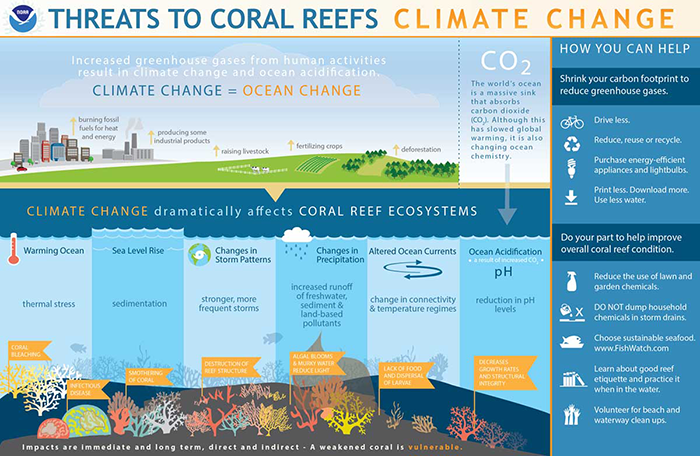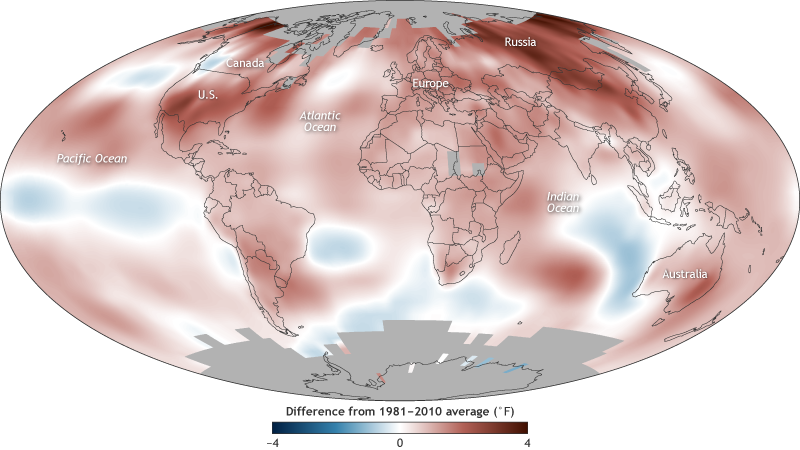National Climate Assessment Released: Human Activity the Cause
Special Stories
23 Nov 2018 6:49 PM
A large climate report has just been released by the United States government and it highlights human activity as the key factor for rising global temperatures, but also lists human activity to help temper the pace of our warming world.
 The report was released by the United States Global Change Research Program, or USGCRP. It focuses on the 'why' of the chart above. Why is the Earth warming? What are the side effects? How much can be done? This is the fourth such report issued by USGCRP and its purpose is to deliver a report to Congress and the President about the state of the climate, effects on agriculture, land and water resources, transportation, etc. as well as analyzing trends in global change (historical, and through the next 25-100 years).
Admittedly the report is in depth and takes quite some time to fully read through. If you click/tap the link below, you can read the entire report.
Click/tap here for the full National Climate Assessment
The USGCRP released ten key messages, which we've written below:
The report was released by the United States Global Change Research Program, or USGCRP. It focuses on the 'why' of the chart above. Why is the Earth warming? What are the side effects? How much can be done? This is the fourth such report issued by USGCRP and its purpose is to deliver a report to Congress and the President about the state of the climate, effects on agriculture, land and water resources, transportation, etc. as well as analyzing trends in global change (historical, and through the next 25-100 years).
Admittedly the report is in depth and takes quite some time to fully read through. If you click/tap the link below, you can read the entire report.
Click/tap here for the full National Climate Assessment
The USGCRP released ten key messages, which we've written below:


 (All images courtesy NOAA & climate.gov)
So what can we do? We can make small changes on our own of using less, recycling more, reducing our own emissions, and getting involved in local/regional decision-making to address the changing climate. Once again, we've provided the link to the full climate report above the key messages.
For WeatherNation, Meteorologist Steve Glazier
(All images courtesy NOAA & climate.gov)
So what can we do? We can make small changes on our own of using less, recycling more, reducing our own emissions, and getting involved in local/regional decision-making to address the changing climate. Once again, we've provided the link to the full climate report above the key messages.
For WeatherNation, Meteorologist Steve Glazier
 The report was released by the United States Global Change Research Program, or USGCRP. It focuses on the 'why' of the chart above. Why is the Earth warming? What are the side effects? How much can be done? This is the fourth such report issued by USGCRP and its purpose is to deliver a report to Congress and the President about the state of the climate, effects on agriculture, land and water resources, transportation, etc. as well as analyzing trends in global change (historical, and through the next 25-100 years).
Admittedly the report is in depth and takes quite some time to fully read through. If you click/tap the link below, you can read the entire report.
Click/tap here for the full National Climate Assessment
The USGCRP released ten key messages, which we've written below:
The report was released by the United States Global Change Research Program, or USGCRP. It focuses on the 'why' of the chart above. Why is the Earth warming? What are the side effects? How much can be done? This is the fourth such report issued by USGCRP and its purpose is to deliver a report to Congress and the President about the state of the climate, effects on agriculture, land and water resources, transportation, etc. as well as analyzing trends in global change (historical, and through the next 25-100 years).
Admittedly the report is in depth and takes quite some time to fully read through. If you click/tap the link below, you can read the entire report.
Click/tap here for the full National Climate Assessment
The USGCRP released ten key messages, which we've written below:
- Between 1901-2016 the global temperature has risen +1.8°F and was caused by human activity
- Rising global temperatures will continue this century, but could be limited. If strong action is taken to lower greenhouse gas emissions, the rise in temperature may be limited to +3.6°F by 2100 (compared to preindustrial times). If no action is taken, the rise could be as high as +9°F globally by 2100
- Since the mid-20th centrury, oceans have absorbed most of the CO2 which is making it more acidic, disrupting currents, and rising (sea levels)
- Seas have risen 7-8 inches since 1900, half of that occurring since the year 1993. Rising will continue to a total of 1-4 feet by 2100 or even up to +8 feet
- The Contiguous U.S. has risen +1.8°F since 1900 and will continue to rise in the next few decades, and possibly +3 to +12°F by 2100
- The Northeast U.S. is getting wetter and the Southwest U.S. is getting drier. More snow is falling as rain and the West is observing a trend of less snow pack
- The Arctic is warming twice as fast as the rest of the globe and contributing to rising sea levels, as well as increased greenhouse gas emission due to perma frost thawing
- Heavy precipitation events are becoming more likely, including wetter hurricanes
- Coastal flooding is happening more often, and more easily with nor'easters and tropical systems
- Long-term effects are likely to last for decades and some warming projections may be underestimated


 (All images courtesy NOAA & climate.gov)
So what can we do? We can make small changes on our own of using less, recycling more, reducing our own emissions, and getting involved in local/regional decision-making to address the changing climate. Once again, we've provided the link to the full climate report above the key messages.
For WeatherNation, Meteorologist Steve Glazier
(All images courtesy NOAA & climate.gov)
So what can we do? We can make small changes on our own of using less, recycling more, reducing our own emissions, and getting involved in local/regional decision-making to address the changing climate. Once again, we've provided the link to the full climate report above the key messages.
For WeatherNation, Meteorologist Steve GlazierAll Weather News
More